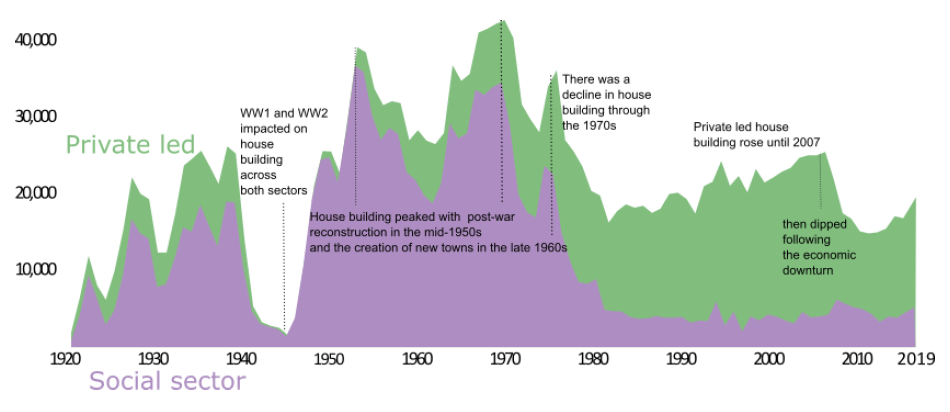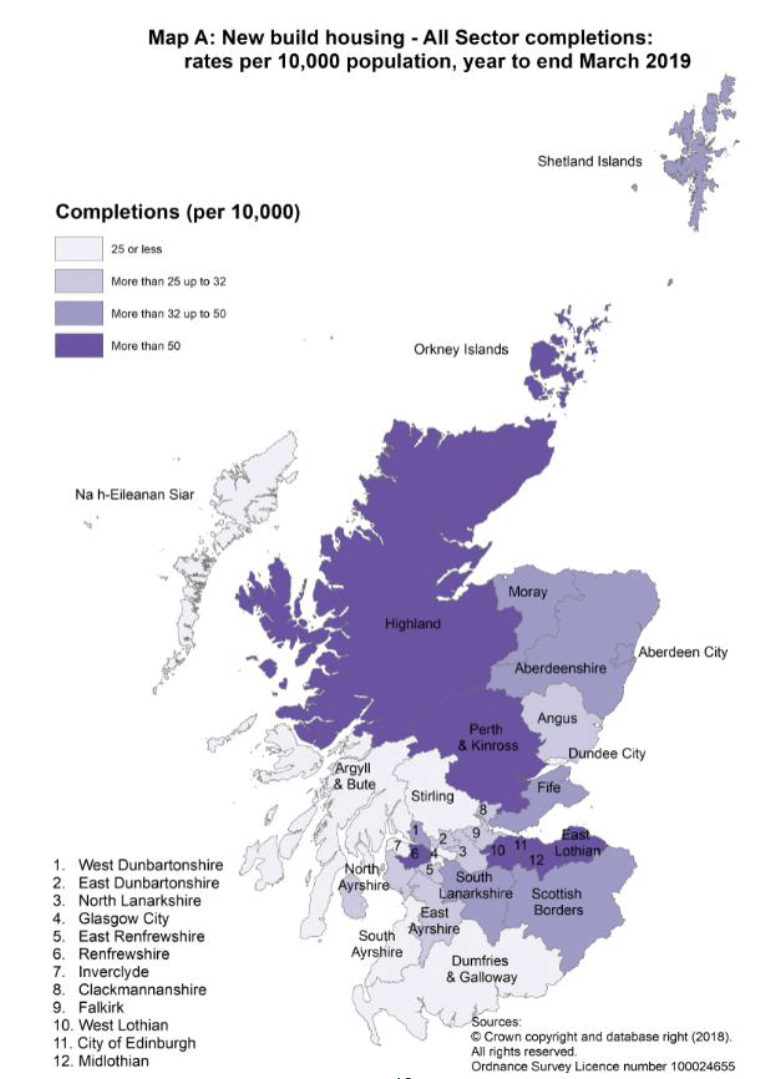Housing statistics 2019: key trends summary
Annual statistics up to 31 March 2018 on total new housing supply in Scotland across all sectors, along with information on various elements of local authority housing such as stock, lettings, house sales, evictions, housing lists, and housing for older people and people with disabilities.
New House Building
In 2018-19, 21,292 new build houses were completed in Scotland, an increase of 3,669 homes (21%) on the previous year when 17,623 had been completed, the sixth consecutive annual increase and the highest annual number of completions since 2008-09.
During the same time period the number of new houses started increased by 3,160 homes (16%) from 19,604 in 2017-18 to 22,764 in 2018-19.
The late 1960s and early 1970s saw about 41,000 to 43,000 new houses completed each year. This was primarily due to programmes of post-war reconstruction and slum clearances which saw huge numbers of, predominantly public sector, housing being built.
Throughout the 1970s and early 1980s the level of new build fell and fewer than 20,000 homes were completed each year throughout much of the 1980s. This was caused by a large decline in the number of social sector houses being built. Meanwhile the number of new private houses was generally on the rise and continued to increase until the economic downturn in 2008. By 2007-08 private sector new build represented around 84% of all completions compared to between 3% and 7% in the early part of the 1950s.
Chart 3: New housebuilding output has been impacted on by various factors in the past, such as the two World Wars, post-war reconstruction activity, the creation of new towns, and the economic crisis in 2007 (note that this chart presents calendar year figures)

The recession hit the private house building industry particularly hard and by 2012-13 starts and completions had fallen by 47% and 54% respectively since 2007-08. The numbers of homes completed by the private sector increased on an annual basis each year between 2012-13[1] and 2016-17, then decreased slightly 2017-18 before increasing in the latest year 2018-19. The number of starts stands at 16,045, up by 19% from 2017-18, but 20% below the number started in 2007-08. Private sector completions meanwhile have also increased by 21% since 2017-18 to 15,710, 27% below the level in 2007-08.
In September 2013 the Scottish Government introduced the Help to Buy (Scotland) scheme which has aimed to support buyers purchasing a new build home and to stimulate the house building industry. Following this, the Help to Buy (Scotland) Affordable New Build and Help to Buy (Scotland) Smaller Developers schemes were launched on 21 January 2016. Further information on the schemes, along with monitoring information setting out numbers of sales and the characteristics of buyers, is available at http://www.gov.scot/Topics/Built-Environment/Housing/BuyingSelling/help-to-buy.
In general, the number of starts will be a strong indicator of the likely trend in completions over the longer term, but there may well be differences over the short and medium term. These differences depend on factors such as the housing market, economic climate, access to finance, and speed of construction.
A wide range of factors can influence the length of time it takes for a new private dwelling to be constructed, including the type of property (house, flat etc.), and the overall size of the site. Depending on the size of the site, it has been estimated that the average time from start to completion of the entire site can range from anywhere between around 1.5 to 2.75 years. Individual homes, or blocks of homes, might be completed in shorter timescales if parts of the site are completed in advance of the rest.
There were 4,169 Housing Association new build completions in 2018-19, 33% more than in 2017-18. There were 4,838 Housing Association new build approvals in 2017-18, an increase of 3% on 2017-18.
After years of very few local authority new build housing completions in Scotland the Scottish Government’s introduction of the Council House Building programme in 2009-10 has seen a significant numbers of new council houses being built. There were 1,413 local authority completions in 2018-19, which is 51 houses (3%) less than in 2017-18. There were 1,881 local authority starts in 2018-19, 507 houses (37%) more than the previous year.
The average timescale from start to completion of a local authority site has been estimated to be approximately 1 to 1.25 years, rising to around 2 to 2.5 years for some of the bigger sites. Individual homes, or blocks of homes, might be completed in shorter timescales if parts of the site are completed in advance of the rest.
The map on the following page shows the rates of housing completions in 2018-19 (across all tenures) relative to the population size of each local authority in Scotland. The highest rates were observed in Midlothian, East Lothian, Perth & Kinross, Highland and Orkney Islands. The lowest rates were observed in Dumfries & Galloway, Dundee City, Stirling, Na h-Eilean Siar and Argyll & Bute.
Link to tables on new builds: http://www.scotland.gov.uk/Topics/Statistics/Browse/Housing-Regeneration/HSfS/NewBuild
Link to Quarterly Housing Statistics for September 2019, which contains further details on new build housing activity and on comparisons to other UK countries:
http://www.gov.scot/ISBN/9781839601804

Contact
Email: lyndsey.middleton@gov.scot
There is a problem
Thanks for your feedback